
Enigma
Overview
Enigma is a tile-laying game with a twist. Players choose a tile seeking to connect powers cells of the same color to score points. However each tile is also a puzzle that must be solved to be placed. If players solve the puzzle then they win the right to place the tile, expanding their system of power cells and potential points. Fail to solve the puzzle and you must discard your tile. When one player reaches 15 points, the player with the most points wins.

Set Up
There are four different sets of tiles in the game; each a different type of puzzle: Weight puzzle, Fragment puzzle, Conduit puzzle, and the Angular piece puzzle. These puzzles and tiles are the primary components of the game as they will form the developing game board as the tiles are laid out. Sort and shuffle all the tiles that share the same puzzle icon on its front and place them on their matching “puzzle chambers” puzzle side down. Also grab the matching puzzle pieces and place them on the illustration on the same chamber cards. The one starting tile is placed in the middle of the table. Next, each player chooses four Networker pawns of the same color and places one on the “0” space on the scoring wheel. Place the sand timer in the middle of the table give the youngest player the Starting Player pawn and get ready to fire up those neurons!
Gameplay
Enigma is played in a series of rounds. Each round has four steps: Choose a puzzle, solve the puzzle, place your tile and then score any closed conduit systems.
Choose a Puzzle
Beginning with the first player, each player chooses an Enigma puzzle to solve. You can see the power cell and conduit system of the top tile on each puzzle chamber, and of course you can choose the type of puzzle you wish to attempt. Take the tile, keeping it face down, and the matching puzzle pieces for that puzzle type. Once all players have a tile in front of them and feel they have wiped the cobwebs from their brains, we move on to the next step.
Solve the Puzzle
This is the heart of the game. Player simultaneously turn over their tiles and attempt to solve their puzzles. Each type of puzzle presents a different challenge:
- Weight Puzzle: This puzzle card depicts a scale with two cups on either side. A number below the cup denotes how much one token weighs when placed on that cup. You must place tokens on the cups so that the total weight is equal on both sides. (Essentially making the total sum of the value of the numbers match on both sides).
- Fragment Puzzle: Cover the outline on the tile using the 7 puzzle pieces. (Essentially a Tangram and usually quite tricky!)
- Conduit Puzzle: Place the conduit pieces on the available spaces so that all the conduits are connected or closed. In some puzzles, some of the pieces are not used.
- Angular Piece Puzzle: Perhaps the most challenging: the 3 dimensional pieces must be connected so that when looked at from directly above they match the illustration on the puzzle card. Tough thing here is, there can’t be any gaps or spaces between the pieces.




When one player solves their puzzle they turn over the sand timer. (adding a slight gesture or noise of satisfaction to annoy the other players). All other player now have until the timer runs out to solve their puzzles. When the timer runs out, all players stop. And now we move on to…
Placing your Tile
Not so fast! If you did not solve your puzzle you must place it back in the game box, fold your hands and wait while the smarter players place their tiles. The real kicker here is there are no solutions. If you fail to solve your puzzle you don’t even get the satisfaction of knowing how close you were to the right answer. Man, this game punishes.
But let’s say you solved your puzzle. Clever you! Flip the tile and again in player order you can connect it to any face up tile already in play. In doing so, you can create a longer conduit or cap off a conduit. The conduit system then can either be open or closed. Immediately after placing your tile you may place one Networker token on one power cell on the tile you just placed. But only if that conduit system doesn’t have another networker on that same color power cell.

Score
Finally, any closed conduit systems are scored. If you closed a conduit, you score one point for each power cell in that conduit that has the same color as the power cell where your networker pawn was placed. Track your score on the scoring wheel then remove all your networkers from the closed conduits.
If no one has reached 15 points, the game continues. Players return their puzzle pieces to the puzzle chambers and the start player token is passed to the left. And a new round begins. If however a player has reached 15 points the player with the most points wins.
Components
Production quality for the game is very good. The main components: the puzzle tiles are a good thick cardboard that will hold up to multiple plays (and from being thrown across a room in frustration.) The graphic work on the conduit sides of the tiles is unique , creating a cool look to the table top. There is not a lot here, but it’s exactly what’s needed.
Learning Curve
Low. Learning how to play the game is snap of course, (like saying all you need to do to solve a crossword is “fill in letters”). But the dual challenge of puzzle solving, along with a strategic choosing and placement of tiles to maximize points does take a few games to get the hang of. You can jump right in but may walk away frustrated.
Who would enjoy this game?
Final Thoughts
Enigma is a great surprise. Certainty it’s an abstract strategy game at its core. Pawn placement on colored power cells and strategically closing off conduits determines your score round by round. But you have to make a picture of a duckie to do so! Tile laying and route scoring ala Carcassonne combined with a Cranium –like action phase. Does this make it a great game? It depends on what sort of person you are.
There are people who enjoy puzzle solving and those who don’t. Even so, if you aren’t a puzzle aficionado, this game offers you a choice in several puzzles that you may excel at. There’s the mathy puzzle , the visual acuity puzzle, the three dimension spacial test and the visual logic test. The only thing you don’t have to do is draw or answer trivia. (Thankfully). Choosing your puzzle is important but is countered with the reality that you may need to deviate from your strong suit because of the colored power cells you need to maximize your score. You may have to choose math over tangram to get that one green power cell that will cap of your conduit route and give you a big score. Like many games it offers the chance to play it safe for a more assured scoring opportunity, or risk failure for the greater reward. So if the word puzzle scares you, don’t turn tail just yet. Enigma offers a great balance – playing to your strengths and forcing you to overcome your weaknesses when it comes to your intelligence.

Another unique feature of the game is the fact that it operates in two distinct game play experiences. In other words, it’s “thinky” in two very different ways. The first of course is the puzzle solving. After a bit of banter and indecision, the puzzle tiles are flipped and the tension and silence are so thick you can cut it with a spatula. Then you hear the flip of the timer and sweat begins to drip of your eyebrows. Finally, time is called and the next phase of the game begins. If you solved your puzzle now you must look at the tile you chose and place it, and possibly a networker, to create the best score possible; taking away opportunities from other players or having them taken from you. You have to be reactive and tactical but definitely be planning ahead to the next round. It’s a good mix, moves quickly and changes from game to game thanks to different tiles that are available in each game and… did I mention that you don’t get the solutions to the puzzles!? Ghah!
Touko Tahkokalio has created something that hasn’t existed yet: a great mix of two very different play styles making it accessible and challenging with an almost artificial intelligence that inspires revenge with every lost game.
If you are looking for a thematic game, it’s not this one. The rule book makes a valiant and very creative effort to instill a theme in this very abstract experience. It challenges you to…
“…shed light on the mechanical shadow world frozen in space.”
And
“… restore the OTHER side of ENIGMA to life.”
I’m not really sure what this means. But it’s not necessary. This game is IN your head, and at times IN your face and because of its amazing challenge and unique game experience it should be IN your collection.
User Reviews (1)
Add a Review for "Enigma"
You must be logged in to add a review.

This game is a marriage of a number of different types of games:
1) A puzzle game
2) A strategy game
3) Tile placement game
4) Worker placement game(ish)
When combining different types of play you run the risk of congesting game play and bogging down the game with itself, but in the case of Enigma that doesn’t happen. All the game play elements work very well together creating a game that will challenge you with every decision. Game play works in the following manner:
The first player chooses a tile from one of the four different puzzle stacks. They are choosing based on the image on the top of the card of different types of conduits used to build and close electrical conduits to gain points.
Once the first player has chosen the other player/s choose in order, but only one of each type of puzzle can be chosen per turn limiting the game to four players. the types of puzzles are listed below:
1) Weights and measures: the player is assigned a certain number of wooden cubes representing “weights” to be used on a picture of a scale to balance both sides evenly (it’s trickier than it sounds)
2) Fragment puzzle: You’re presented a shadow image that you have to fill in using different shaped pieces
3)Conduit Puzzle: You have to connect and close off plumbing conduits with no open or blocked ends
4) Psychedelic colored block puzzle (not what it’s called, but how it seems!) You have to stack a series of colored blocks to form an image as viewed from above.
Once all the players have chosen a tile they simultaneously turn the tile to reveal their puzzle and begin to solve it. Once the first person solves their puzzle they then flip over the timer giving the remaining players 60 seconds to finish theirs. Once the timer runs out any players unable to solve their puzzle return the tiles to the bottom of the corresponding stack. The first player then “places” their tile wherever they choose as long as the tile they’re connecting to has an open conduit end. They then get to place their “worker” meeple on a conduit scoring points if the conduits is closed for each worker on the conduit. Play continues in this manner until a player reaches 15 points earning them the victory!
OVERALL IMPRESSION: I was impressed with how much strategy there really was in this game. I wasn’t expecting there to be much because I thought the game would focus more on the puzzle aspect, but when you get into building and closing conduits and choosing puzzles based on what other players have chosen as well as where you place your workers strategy is necessary. Now don’t get me wrong, it’s not chess, but if you’re a strategy gamer I think you’ll enjoy it.
The puzzles are really fun as well. There are some that will make you want to throw them across the room, but you won’t rage quit because of them and with the number of them in the game you’ll be able to replay this quite a few times before memorization becomes a factor.
The one detractor is the theme. It’s pasted on and unnecessary. I love thematic games for the immersion they provide, but in the case of Enigma you’ll be immersed in the puzzles and decisions to be made so theme can go out the window.
I hope this review will help you in regards to Enigma. I’m new to review writing so forgive me if I’ve neglected anything otherwise enjoy gaming!